 |
 |
 |
 |
 |
 |
 |
| 2010 SUPER GT Rd.4 (Sepang) |

|
"Hey! What's up?" Mr. Amemiya greets me with a familiar smile. I congratulated him on the victory in round 4 at Sepang. It was good as he had declared he would absolutely win at Sepang before heading to the race.
Amemiya: "Thank you very much. Because not many races are held there, Sepang is gentle on tyres, and the road resistance is pretty low. The RX-7 has less torque so accelerates easily on the low friction track. Also, because the RX-7 has 50:50 weight distribution and is a well balanced car, it is very strong at Sepang. Of course it relies on Yokohama tyres to win races. It's easy to put in place a winning race strategy. Our result is just a follow-through on that strategy. On the other hand, we have some technical knowhow regarding modifications of the cooling system in response to the scorching hot weather found in Sepang. Our five victories from 10 races at Sepang is really great, isn't it? We've always finished within the top 10."
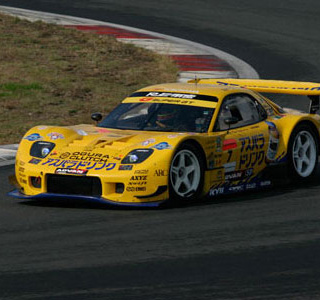 |
 |
| 2006 SUPER GT Final Round (Fuji) |
 |
MZ Racing: Please tell us about your most memorable race in Super GT. And let us know about your plans for racing next year.
Amemiya: "Well, both the final race in 2006 and in 2009 are memorable for me. We wrapped up the series' title there in 2006, and lost the title there in 2009. Both races ended with a narrow margin, and that's why I remember them. It was a bitter disappointment last year. However, I'm campaigning this year because of that loss. Our RX-7 will be given to our Malaysian sponsor after the end of this season. Actually, we already gave the RX-7 to our sponsor last year, but through his kindness, the sponsor let us campaign the car again this season. Therefore, it is a case of going completely back to square one next year. Racing is a lot of fun. Many customers support us, which encourages us a lot. We feel that we absolutely have to do our best because we are representatives of the Rotary Engine."
 |
 |
| Mazda Familia Rotary Coupe |
 |
In the early 1970s in Tokyo, young Isami Amemiya reached a turning point, owning a Mazda Familia Rotary Coupe. At that time, Amemiya Motors was mainly a car body and paint shop. And a lot of rotary-engined Mazdas were brought to the shop. Mr. Amemiya was fascinated by the small size and light weight of rotary engines, not to mention their high power and ease of installation/removal. That's what started the rotary tuning that continues to this day.
When tuning a reciprocating engine, honing the cylinder block, polishing the cylinder head, processing valve sheets and pistons etc. all need to be outsourced to a special processor. Either that or the purchase of a lot of specialized and very expensive equipment is required. However, thanks to their simple construction, rotary engines can be tuned with small amounts of equipment and a minimum amount of investment - and a person's own skill. This is the greatest reason for choosing rotary engines, Mr. Amemiya commented.
 |
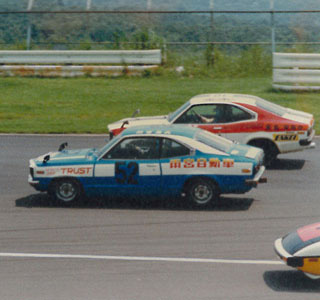 |
| Savanna RX-3 that Amemiya drove |
 |
What is the trigger that got you interested in motorsports?
Amemiya: "My interest began when I went to see a race at Fuji Speedway in my Mazda Familia. I was inspired when I saw the Mazda Familia and Mazda Capella campaigning the race and running really great. I remember that I got an autograph from Mr. Yoshimi Katayama. Much later, the first race I took part in was in the P-II class of the Fuji Freshman race. The car was a Mazda Savanna RX-3. I campaigned it from 1978 to 1981. My best result was probably third place. Later I stopped driving, hired another driver and switched to the RX-7, and we became champions! At that time, I realized that I was better working as a mechanic. Building the engine and letting the car run is my job, first and foremost."
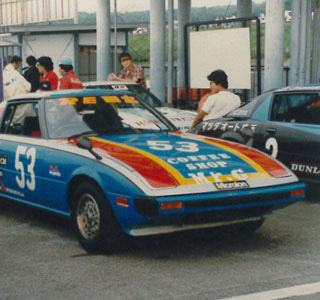 |
 |
| SA22C RX-7 Champion of Fuji Freshman race |
 |
Amemiya: "I campaigned the Fuji Freshman race series not only in a Savanna RX-3 and SA22C RX-7, but also in a FC3S RX-7 and a Eunos Roadster - which doesn't actually use a rotary engine. I learned a lot about engine building. Because of the regulations, there were not so many places where one could modify the engine so we researched and developed ways to make more power within the limited situation.
I was really confident about the FC3S rotary engine.
I achieved a record of seven wins from eight races with that unit. Also, powerful rivals such as Knight Sports, ERC and Yours Sports came on the scene, and things started getting very serious."
A total of 120 SA22C RX-7s participated the Fuji Freshman race in the late 1980s. There were two races for each class of RX-7. Many young drivers stepped up to a higher racing class from this experience.
 |
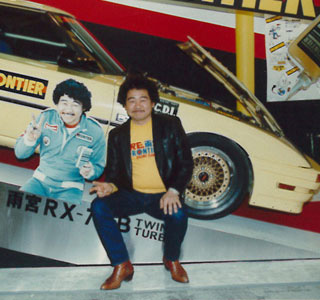 |
| Beard and Shaggily hair is Amamiya's trademark |
 |
Amemiya: "Thereafter, the Japan Supersports Sedan race (JSS) started so I campaigned that full-scale race in an FC3S RX-7. We were able to use our own originally-developed parts such as aero spoiler, suspension system etc. for the race, therefore we developed those parts through repeated trial and error. Our original for-street parts into which we put our experience sold well. Thanks to those sales, we were able to keep our business afloat.
I also participated in some automobile magazine events such as the maximum speed trial at Yatabe test course, JARI, 0-400m, and time-attack events at Tsukuba Circuit. I remember the maximum speed trial and 0-400m at Yatabe test course, JARI, well. We participated with a Savanna wagon equipped with a 10A sideport rotary engine with normal carburetor. We recorded a maximum speed of 194km/h and a 12.45-second 0-400m. We beat the more expensive S20-engined Skyline GT-R.
I was very glad."
Thereafter, RE Amemiya racing campaigned the Japan GT Championship (JGTC) with an originally-tuned FD3S RX-7.
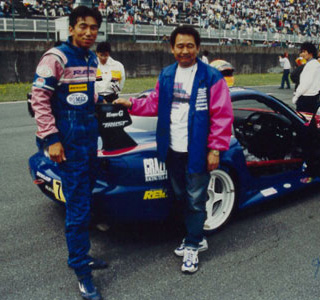 |
 |
| JGTC specification RX-7 in 1996 |
 |
Amemiya: "In the beginning of the JGTC, we entered with a relatively unmodified JSS spec. RX-7. In 1995, it was still possible to take part as something of an amateur. We took 2nd place in our first race. In a sense, we began to enter the races with only our spirit, but soon the races became more professional, and were increasingly fought over by professional teams. In a professional race situation, private teams like ours found the situation very difficult. But, because it was racing, we wanted to win and we spared no efforts. There are nothing to replace the sheer joy of taking victory. Our supporters and fans encourage us and I think it means something to keep racing as long as our supporters and fans continue to cheer us on.
I hope our race activities help to keep motorsports alive, and our efforts will contribute to Mazda's return to racing."
|
 |
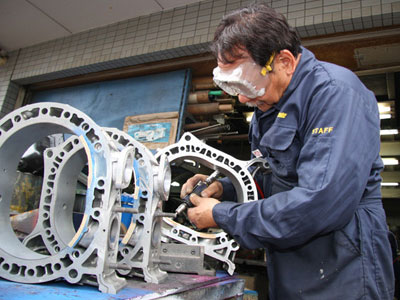 |
| Amamiya does the port processing |
 |
The author feels that his purely dedicated and wholehearted devotion to his work, and his personality grabs a lot of fans' emotions. Even nowadays, Mr. Amemiya still builds his special rotary engines at his garage on Koto-ku, Tokyo.
Amemiya: "Whenever I have spare time,
I build engines both for racing and for the street.
I do the polishing of the rotary housing, too. These are the roots of RE Amemiya and it is fun when I finf something new, even now. Furthermore, everybody is surprised when I tell them that I build the three-rotor racing engine for Super GT. Surely, we can't say this garage is clean - even as flattery."
After finishing the interview, Mr. Amemiya started to put away some corrugated boxes in his garage in a leisurely way. The author felt very warmhearted by his words "Please come again."
|

|
|
|
 |
 |
|